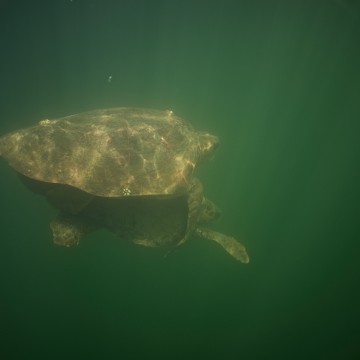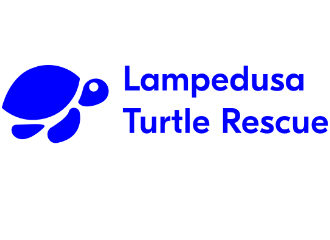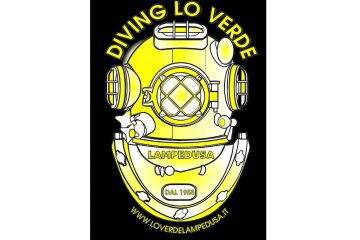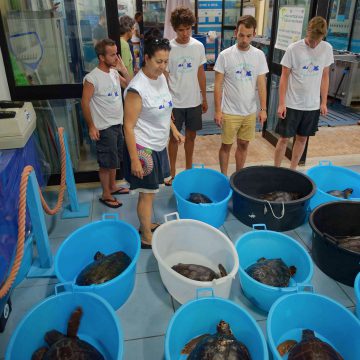
The Lampedusa clinic (Italy – 2016)
The island of Lampedusa is famous for the stories of migrants who risk their lives to reach its European soil. But this isolated rock holds a secret: a very special clinic helps to save hundreds of injured marine turtles. What may seem like a drop of water is in reality a necessity for the survival of the Mediterranean.
Lampedusa is an arid island of 20 square kilometers surrounded by the Mediterranean Sea. It’s a beautiful little piece of land that is fascinating for several reasons.
It happens to be the Africa’s closest European Union territory, Tunisia being just over 100 km away. During the past several years, this Italian island was put under the spotlight for its role in the migrant crisis, being one of the privileged destination for thousands of people escaping their country of origin, mainly Somalia, Soudan and Eritrea.
But Lampedusa is also the home of a very different story, one that has hardly ever been told. The island offers one of the most important clinics in the Mediterranean for injured marine turtles. At the head of the center, Daniela Freggi, a Franco-Italian who dedicated the past 20 years of her life to assist and help these peaceful animals known to swim in our seas and oceans since prehistorical times. Although the species is one of the oldest we know of, our knowledge is still surprisingly limited.
Over the years, Daniela built a relationship with the fishermen. They now bring her the sick or injured turtles they find while at sea. As well as the healthy ones they catch by mistake on their fishing lines. Since the clinic’s opening, hundreds of turtles up to 40kg have had their lives saved on the operating table. Alongside an Italian veterinary surgeon, Daniela developed cutting edge surgical techniques that have since been broadcasted around the world. Once healthy, the injured turtles are set free where they belong, in the open sea. But not without tagging them for further research.
The turtle center on Lampedusa performs something that may seem trivial. Yet, its objective gains in importance once we learn that marine turtles are the main, if not the only, jellyfish predators. If turtles come to disappear, the sea sea may turn into a hostile environment, invaded by stinging gelatinous creatures. For our own sake, it is crucial to expand our knowledge and educate the public on the threats the turtles currently face.
Direct support to the Lampedusa center
The Octopus Foundation helps the turtle clinic on Lampedusa through the delivery of medical equipment, allowing the team to better diagnose and treat the injured animals. Furthermore, tracing and tracking equipment will also be financed in order to better understand the turtle’s seasonal migration and everyday movement.
Media for the public
In addition to this financial support, the Octopus Foundation will develop mainstream medias so that this key species for the health of our seas is better known. These medias will also help to understand the animal’s behavior, biology, the threats it is facing and what solutions can be developed to help and save them.
How to locate and observe marine turtles with a drone
During one of the Octopus Foundation’s missions to support the surgical clinic for marine turtles in Lampedusa (and towards the general study of marine turtles in the Mediterranean sea), we have been lucky to witness a rare occurrence: the mating of Caretta Caretta marine turtles. With this document, we wish to explain the experimental method we developed to locate and approach them, so that any scientist who wishes to can replicate it or modify it to suit his or her needs.
SITUATION
Apart from a few yachts who transit from the Ionian Sea to the Aegean Sea, almost nobody knows about the small port of Messolonghi in Greece. This little provincial town, located at the entrance of the Gulf of Patras, harbors a biological singularity: a stretch of sea water of approximately 3 square kilometers at the end of a long canal is the home of a dozen marine turtles almost all year long.
The port of Messolonghi is split in three different areas: the marina, the small fishing harbor and a large stretch of water where transit yachts can anchor. At first glance, the presence of a small city (appr. 13’000 inhabitants) and the human activity related along the port would deter wild animals to approach, let alone live, feed and mate in this area. But the marine reptiles in Messolonghi have apparently adapted to this unusual situation.
SURFACE OBSERVATION
It is tricky to observe marine turtles from above the surface, because they are true apnea champions. Some turtles can dive during 30 or 40 minutes while holding their breath. This skill has a physiological explanation: marine turtle blood has a hemoglobin rate seven times higher than human’s blood (this is why it is purple and not red). For an observer on land or on a boat, the only chance to see a marine turtle is during the few seconds when it comes back to the surface to take its breathe.
For a few days, we have tested a technique for the localization of marine turtles, in order to approach them as calmly as possible and observe them in their natural habitat. In the next few paragraphs, we will explain the different steps necessary to achieve this and what were the results for this particular situation, hoping that it will help future research.
METHOD
a) Teams
We separated the available people in two groups:
– The first one, on land, consists of the drone pilot and his assistant who will give him general directions and observations.
– The second group, on an inflatable boat, consists of the pilot of the boat, an observer
who has access to the drone’s video feedback and a snorkeler with mask, tuba, fins and an underwater camera.
No more than 5 people are necessary for this method, and it proved efficient in the field.
b) Up in the sky
Considering the specifics of the location and the observation zone (approximately 3km2), we decided to first try and locate the turtles from the sky, with the help of our drone.

Our drone is equipped with a small camera and a live video feedback that allows us to easily locate marine turtles that are between the surface and depths up to 4-5 meters.
Despite the parasites and algae that covers some of the turtles’ shell, it proves fairly easy to spot the animals in the blurry water (the seafloor is most probably covered with seaweed).
In order to prevent the risk of the turtles being frightened by the noise of the drone’s four engines, we flew between 20 and 80 meters above the sea level.
Once a turtle was spotted by the pilot, he would make the drone hover in position above it, marking the general position of the animal for the team on the inflatable boat. With this method, there is no need of radio communication.
c) Above the surface
In the inflatable boat, the observer has access to the drone’s video feedback on a small monitor (the exact same image that the drone pilot has). Actually, once the drone is up in the air and emitting, anybody with a receiver and the correct frequency can see what the drone pilot sees.
Once the drone hovers over a turtle, the inflatable boat’s pilot can use it as a point of reference to quickly move forward with the engine.
As soon as the boat enters the drone’s field of view, the observer informs the boat’s pilot who can stop the engine, and finish the approach in silence with the oars.
d) Under the surface
Once the inflatable boat is about 20 meters away from the spotted turtle, the snorkeler with his waterproof camera can slip quietly in the water. He then follows the direct instructions from the observer on the boat, who can still see everything on his screen with the video feedback.
The drone then gains a bit of altitude in order to limit the noise, so that the snorkeler and the observer can better communicate.
RESULTS
This method allowed us to approach several turtles. Each of them reacted differently to the snorkeler’s silent approach and presence in the water. Some stayed in the same place, others slowly moved away at the same depth, and some decided to dive. In all cases, we never attempted to chase them down, or block their passage in any way. Moreover, our observation operations above the port of Messolonghi never lasted more than one hour every half day.
Argos – GPS tracking of marine turtles
Salvatore – 2018
On the 21st of October, 2018, after almost two months of rehabilitation at the turtle rescue centre of Lampedusa, Salvatore was set free in the Mediterranean Sea.
Salvatore’s story is astonishing. He was spotted by a local pilot of touristic boat, who really struggled to pull back on board this marine turtle weighing 60kg.
His front flipper was entangled by nylon string, and he was covered in leeches, which is a sign of weakness and delicate condition.
To rid him of the parasites, Salvatore spent 24 hours in a fresh water tank. Then his flipper was mended by Daniela Freggi and her team of volunteers. To get him back in shape, he was feed 30 fish and squids a day for almost two months.
In order to follow his journey back to a free and healthy life, a GPS tracker was glued to his shell. It is a floating device, which connects to the satellite network as soon as the turtle swims close to the surface.
Here is his trail:
Hope
 In April of 2018, it was Hope’s return to the sea that was going to be monitored with a beacon. The 15kg marine turtle was equipped with a GPS transmitter half the size of that of Homerous. The small battery allowed the device to transmit for almost three months, from 25th of April to 21st of July 2018.
In April of 2018, it was Hope’s return to the sea that was going to be monitored with a beacon. The 15kg marine turtle was equipped with a GPS transmitter half the size of that of Homerous. The small battery allowed the device to transmit for almost three months, from 25th of April to 21st of July 2018.
The Italian biologists scrutinized the map, to see if Hope was able to swim against the winds and currents. Indeed, she did, which means she had perfectly healed from the cutting-edge surgery and rehabilitation techniques developed at the Lampedusa center.
Homerous
In 2016, the Octopus Foundation purchased a GPS beacon and glued it to Homerous‘ shell. When the marine turtle comes back to the surface to breathe, the transmitter connects to a network of satellites and sends its precise position. The Argos beacon stopped emitting once the battery died out, on the 19th of May 2017, a little less than seven months after the historical release.
With the help of web developers, the Foundation created an easy to use map to follow Italy’s most famous marine turtle.
Olympus – Diving profile of a wild turtle
After being rehabilitated at the Lampedusa Turtle Rescue center, the marine turtle nicknamed “Sophie” was released near the coast of the small Italian island in July of 2016. In order to experience what it feels like to be a turtle in her natural environment, we strapped an Olympus camera (Tough TG tracker 4K) to Sophie’s shell and followed her for about 25 minutes. This camera also allowed us to collect data on her diving profile, as it uses a barometer to calculate the depth at which each photo is taken.
Here is the time lapse video :
Below is the collected data. On the left of the image is Sophie’s trajectory during the recording. In the center, the cycle of diving and surfacing for air, and on the right (in french) different data such as temperature, average speed, and other interesting information.

Rescuing marine turtles in Lampedusa – 2018 Full Documentary
In April of 2018, the Octopus Foundation crew went once again to Lampedusa, in order to support marine biologist Daniela Freggi and her team of volunteers. Isolated on this tiny Italian island, Daniela managed to create one of the most important centres for study of marine turtles in the Mediterranean. The clinic is now known worldwide for the cutting-edge surgical techniques that they developed. Follow Daniela’s story alongside “Hope”, a young marine turtle who literally came back from the dead.
YouTube playlist
The Octopus Foundation published several videos following its mission to help the turtles of Lampedusa.
For example, you’ll discover Homerous’ first minutes after being released in the wild, as well as time-lapses of smaller turtles swimming in the Mediterranean sea.
In this section, you can freely download this mission’s pictures and documents. Contact us if you need one or several high definition pictures.
IMPORTANT: You can use these documents for free if they are part of an informative or educational project. Please don’t use these media in any commercial project. For each media, please add the following copyright : © Octopus Foundation
















































